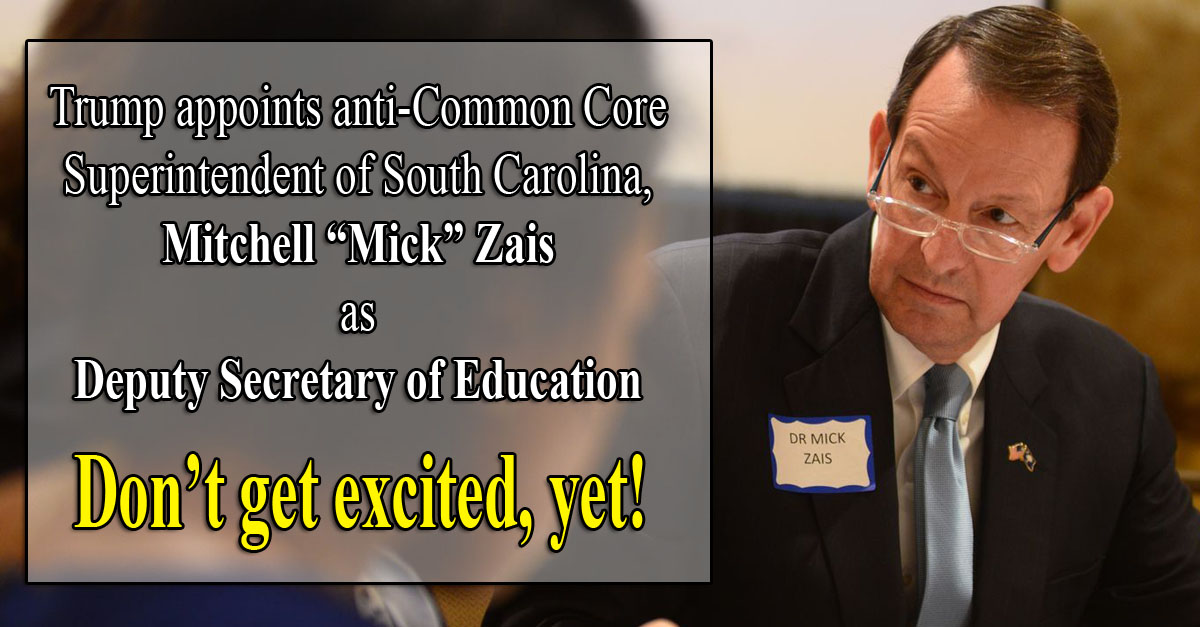
Just one day after the appearances of four high-profile reformers at the Senate HELP Committee’s hearing on ESSA: Unleashing School Innovation praising the efforts and success of Tennessee, Louisiana and New Mexico, the news headlines were ablaze with President Trump’s appointment of Mitchell “Mick” Zais to the office of Deputy Secretary of Education.
Those who have engaged in the fight against corporate education reforms might recognize the name. Zais was the South Carolina Superintendent of Education. He was elected to the position around the same time as former governor, and Trump’s current Ambassador to the United Nations, Nikki Haley was elected. Both ran on a platform to repeal Common Core. Immediately after taking office, Zais famously rejected the Race To The Tops grants citing federal overreach and launched a campaign to repeal Common Core. On May 29th, 2014, H-3893 was ratified by the South Carolina legislature, and signed into law the very next day by Gov. Nikki Haley who proudly stated that implementing Common Core standards resulted in every state educating children in the same way, and “South Carolina children shouldn’t be educated in the same way as California children.” Unfortunately, the bill wasn’t an immediate repeal of Common Core. It established a process to review and revise the standards with the goals of developing a new set of standards custom-made to the needs of South Carolina students. Sound familiar? In the end, a little more than 90% of the standards were unchanged. Apparently, Haley believed that South Carolina children were only 10% different from California children.
Seeing all of the news stories about Zais’ appointment reminded me of the education reformer’s attempt to prevent the collapse of something that an enormous amount of money had been sunk into and keep the momentum going in the education reform efforts. They had somewhat successfully recognized that the term Common Core had become toxic. They conducted research and polls that determined that the general public could be easily fooled by asking their opinion about the Common Core standards compared to the same standards with a different name. A major effort was put into renaming the rose. In November 2015, Sandra Stotsky wrote in the New Boston Post about the efforts in Massachusetts to rebrand Common Core after they dumped the highly-rated standards that she had written in favor of adopting Common Core. She describes the five common tactics used by the reformers to overcome public rejection of Common Core.
— Changing the test’s name: Many states, like Massachusetts, have renamed their Common Core-based tests in order to make parents and legislators in the state think that they are getting something different. Thankfully, in Massachusetts, voters will have a chance to weigh in on the underlying Common Core standards, in the form of a November 2016 ballot question asking voters if the state should return to their superior pre-Common Core standards in mathematics and English Language Arts. Parent activists in the state already know that is the only way they can get rid of a Common Core-based test disguised as MCAS 2.0.
— Using restricted review methodology: Some states have used an online methodology that restricts statewide reviewers to a standard-by-standard review and allows state Departments of Education to claim that they have state-specific standards, in some cases mainly because they added standards for grades or courses that won’t be tested.
— Stacking review committees and granting them limited purview: Many state departments of education stack revision committees with Common Core partisans and minimize participation by undergraduate teaching faculty in mathematics and English. Some state departments of education give review committees inhibiting directions, such as telling them not to change more than 15 percent of the standards because of laws against creating entirely new tests. Other faux-revision committees, such as those in Indiana and Pennsylvania, simply paraphrase the Common Core standards or, as in South Carolina, flood the Common Core standards with non-assessable objectives in order to make it difficult for legislators to spot the Common Core standards in their midst.
— Skewing public discussions: Some states set up unbalanced public fora with speakers and commentators who desire further professional work with the department of education and who understand all too well what side of their bread the butter is on.
— Relying on rigged external reports: Other states rely on seemingly unbiased external reports by groups such as the Thomas B. Fordham Institute and Achieve, Inc., both of which are funded by the Gates Foundation, with a vested interest in the Common Core project.
Residents of Louisiana should be able to recognize that all of these tactics have been used in Louisiana. It is safe to say that the end of this fight is nowhere in sight. Buckle up! It’s gonna be a rough ride.

